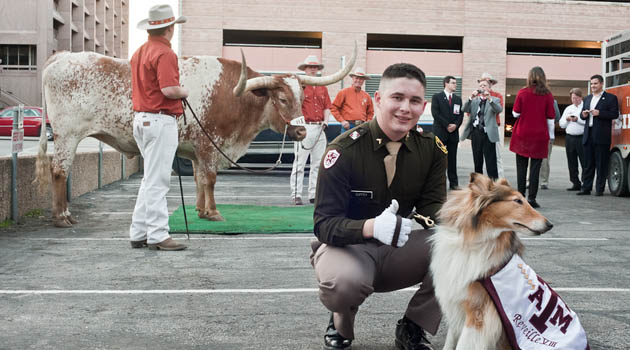End of A&M Rivalry a Chance for New Partnership
An Open Letter to Texas Aggies
When the final whistle blows after the 118th game between Texas and Texas A&M tomorrow night, it will mark the end of something old, meaningful, and special that has long been a part of our lives. Texas A&M and The University of Texas have squared off on the gridiron almost every year for the last 117 years.
The first was in 1894, and Texas won that contest 38-0. (Just between us, I’m not so sure the series will end the same way it began.) That makes the rivalry older than the Notre Dame vs. USC (1926), Michigan vs. Ohio State (1897), and even the Yankees vs. Red Socks (1901). Only Minnesota vs. Wisconsin and Kansas vs. Missouri have played each other more—121 and 119 times, respectively. And get this: when Texas and A&M first played, Oklahoma wasn’t even a state yet.
I’ve been around (in the broadest physical sense) for 28 of those years; this will be my 29th. I can remember in high school idolizing R.C. Slocum, the Wreckin’ Crew, and fearless Aggie linebacker Dat Nguyen, the only player I’ve ever seen tackle Ricky Williams with one hand. My junior year of high school I went to a meeting in San Antonio’s Aggie Park for prospective students interested in the Corps of Cadets.
My most vivid memory of Texas A&M is actually a tough one. In 2000, one of my former summer camp counselors, an A&M Corps graduate and U.S. Marine named Clayton Jack Kennedy, died tragically in an Osprey crash. Clay had been the Combined Band Staff Commander, a Ross volunteer, and a senior red-sash leader, and frankly, I worshipped him. His funeral was held in Rudder Hall, and I’ll never forget the way the Fightin’ Aggie band played for one of their own that day. I can still feel it in my bones.
That’s right, I was an Aggie once upon a time. When it came time for me to head off to college, I ended up choosing Texas because of a very specific program there called Plan II that was the right fit for me. I’ve never lost my admiration for Texas A&M, though, particularly the way Aggies are such a proud family. So I’m personally very sad not just to see this rivalry end but to see it end with such animosity and resentment, which I must tell you is a far cry from earlier days.
Did you know that in 1920, when UT got sick of spending 60 cents a day caring for Bevo, they invited some Austin-area Aggies to the end-of-year football banquet for which they barbecued the beloved steer? Texas then presented the Aggies with Bevo’s hide, which three years earlier some Aggies had branded 13-0. That was the score of the 1915 game in College Station, which A&M won.
A lot of people, by the way, think that that’s how Bevo got his name—that embarrassed Texas fans turned the 13-0 into BEVO to save face. Not true. In fact, two months before the Aggies branded the steer, it was the editor of The Alcalde, of all people, a man named Ben Dyer, who named the steer. In an article for the December 1916 issue, Dyer described how the animal was introduced at halftime of a game. “His name is Bevo,” Dyer wrote. “Long may he reign.” Now you know…
Over the years, there have been lots of shenanigans between Longhorns and Aggies, and the competition on the field and in the gym, in the pool and from the tee box has always been fierce. But as the events at Penn State have recently reminded us, wins and losses are the most primitive way of judging institutional success.
To me, the defining moment of our rivalry occurred 12 years ago this month, after the terrible Bonfire Tragedy. The students, faculty, alumni, and fans of the two schools came together in a way they perhaps never had before or have since. The Bonfire Tragedy helped all of us remember that there are more important things in life than what happens on a football field—something I worry many of us have forgotten lately in the fury of conference realignment.
So here we are, a day before what looks like the end of our 117-year rivalry, and now seems a fitting time to consider a new beginning. Our two schools—our two families—occupy a special place in both the history and future of our state. In the last few decades, A&M and Texas have shed their old regional connotations and emerged as national Tier 1 universities. That transformation has taken time, money, and lots of work.
But the result has been two of the most prolific economic engines the state has ever seen. Together our two schools educate a fifth of the state’s public university students, and with the best graduation rates by far. Countless UT and A&M graduates go on to be civic, industry, and business leaders. Last year UT and A&M together brought in nearly $1.3 billion in research expenditures. All told, every $1 of state support invested in UT or A&M returns $18 to the state. That is incredible.
Yet as the cost of tuition has risen, all of higher education in this state and across the country is facing tough questions about affordability, accessibility, efficiency, productivity, and quality. In Texas, the debate continues to rage over what we want higher education to look like, what we want our colleges and universities to do, and how important we think Tier 1 universities really are.
Texas launching the Longhorn Network or A&M moving to the SEC has nothing to do with any of this. So I propose we set them both aside. More important issues are at stake, and they are being decided right now at both of our alma maters, by our regents and inside the Legislature.
One downside of having two strong, tight-knit families such as Texas and A&M is that people who aren’t members or one of the other can feel left out. Sometimes they can feel resentful. And sometimes they can just be indifferent, which isn’t necessarily bad. But for schools whose futures are being debated in the public sphere, indifference is definitely not good.
There are 25 million people in the state of Texas, and there are only 800,000 or so living alumni of UT and A&M. That’s three percent. If our schools are going to continue to be national academic powerhouses, we must do a better job of helping that 97 percent of the population—most members of which have never stepped foot on either of our campuses—understand why a strong UT and a strong A&M should matter to them.
Since our impending split means we will no longer have to worry about whether the Longhorn Network is unfair, or whether one school or the other is to blame for the conference shakeup, let us today consider a new partnership. A chance to hit reset. A chance to set our differences aside and work together. The future of our state depends on how well our population gets educated, period. And that is on us.
The exclusivity of our two schools—our two families—isn’t a problem, it’s an asset. What Texas parent wouldn’t want their child to attend Texas or A&M? They are the two top public schools in the state, and degrees from both schools are worth a lot. It’s a luxury that Texas students have both as options. I want my kids to be able to choose from two excellent schools—schools that are hard to get into and hard to graduate from. That makes it all the sweeter and more valuable when they do.
And if they chose A&M, great. I’ve been an Aggie before, and I could be one again.


















9 Comments